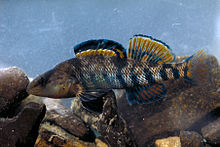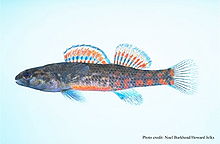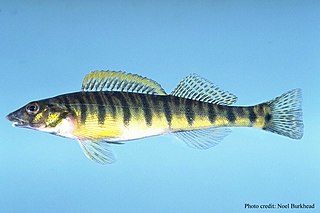
Percina is a genus of small freshwater ray-finned fish, classified within the subfamily Etheostomatinae, part of the family Percidae, which also contains the perches, ruffes and pikeperches from North America. Along with similar fishes in certain other genera, members of Percina are commonly called "darters". More specifically, the genus as a whole is known as roughbelly darters, while certain species of Percina with a pattern of vertical bars on the flanks are called logperches.

Fundulus is a genus of ray-finned fishes in the superfamily Funduloidea, family Fundulidae. It belongs to the order of toothcarps (Cyprinodontiformes), and therein the large suborder Cyprinodontoidei. Most of its closest living relatives are egg-laying, with the notable exception of the splitfin livebearers (Goodeidae).

Notropis is a genus of freshwater fish in the family Cyprinidae. They are known commonly as eastern shiners. They are native to North America, and are the continent's second largest genus.
Macrhybopsis, the blacktail chubs, is a genus of cyprinid fish that are found in North America. There are currently 12 species in this genus.

Madtoms are freshwater catfishes of the genus Noturus of the family Ictaluridae. It is the most species-rich family of catfish in North America, native to the central and eastern United States, and adjacent parts of Canada. Their fin spines contain a mild venom with a sting comparable to that of a honey bee.
The ashy darter is a species of freshwater ray-finned fish, a darter from the subfamily Etheostomatinae, part of the family Percidae, which also contains the perches, ruffes and pikeperches. It is endemic to the eastern United States.
The redband darter is a species of freshwater ray-finned fish, a darter from the subfamily Etheostomatinae, part of the family Percidae, which also contains the perches, ruffes and pikeperches. It is endemic to the state of Tennessee in the eastern United States.
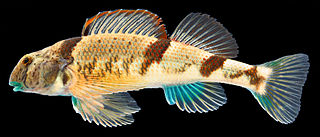
The blenny darter is a species of freshwater ray-finned fish, a darter from the subfamily Etheostomatinae, part of the family Percidae, which also contains the perches, ruffes and pikeperches. It is a poorly known species which occurs in Alabama and Tennessee where it inhabits swift riffles.
The Cumberland snubnose darter is a species of freshwater ray-finned fish, a darter from the subfamily Etheostomatinae, part of the family Percidae, which also contains the perches, ruffes and pikeperches. This species is found in the middle Cumberland River drainage in Tennessee, Kentucky, Virginia, North Carolina, Georgia, and Alabama. It is absent in reaches above the Big South Fork, rare in North Carolina, and absent in western tributaries of the Tennessee River. While research on the ecology of E. atripinne is not extensive, what is known is they are usually found in small to medium freshwater streams in gravel riffle areas where their eggs can attach to the substrate and be left unguarded. E. atripinne can be found within a wide range of depths in its environment, leading its being classified as benthopelagic. While its global status is secure, the American Fisheries Society labels it with a status of “Special Concern”.
The saffron darter is a species of freshwater ray-finned fish, a darter from the subfamily Etheostomatinae, part of the family Percidae, which also contains the perches, ruffes and pikeperches. It is endemic to the eastern United States, where it is found in streams and creeks in Kentucky and Tennessee.

The Barrens darter is a species of freshwater ray-finned fish, a darter from the subfamily Etheostomatinae, part of the family Percidae, which also contains the perches, ruffes and pikeperches. It is endemic to the eastern United States, where it is only known from the Cumberland ecoregion. It inhabits generally quiet pools in headwaters and creeks, often sheltering underneath large rocks. This species can reach a standard length of 7.4 cm (2.9 in). This species forms part of the Etheostoma squamiceps species complex within the subgenus Catonotus and it is further part of the "blackfin darter" group. It was first formally described in 1992 by Lawrence M. Page and Patrick A. Ceas with its type locality given as Duke Creek which is 3.2 kilometres southeast of Hollow Springs in Cannon County, Tennessee. The specific name honours Stephen A. Forbes, who was a noted ichthyologist member of the Illinois Natural History Survey during the early part of the 20th century.
The goldstripe darter is a species of freshwater ray-finned fish, a darter from the subfamily Etheostomatinae, part of the family Percidae, which also contains the perches, ruffes and pikeperches. It is endemic to the southeastern United States where it is found in Gulf Slope streams from the Colorado River drainage in Texas to the Flint River in Georgia, the Atlantic Slope in Ocmulgee River system, Georgia, and the Mississippi embayment north as far as southeastern Missouri and western Kentucky. It is typically found in small springs, streams, and creeks with aquatic and marginal vegetation and detritus. The female spawns on multiple occasions between about mid-March and June, sticking the adhesive eggs to plants, gravel and the sides of rocks. The goldstripe darter is a common species with a wide range and numerous sub-populations, and the International Union for Conservation of Nature has assessed its conservation status as being of "least concern".

The gulf darter is a species of freshwater ray-finned fish, a darter from the subfamily Etheostomatinae, part of the family Percidae, which also contains the perches, ruffes and pikeperches. It is found in Louisiana, Mississippi, Alabama, Florida, Tennessee, and Kentucky. It is a colorful fish, males having vertical barring of red-orange and blue-green near the tail, growing to a length of about 7.8 centimeters (3.1 in). It is typically found in small and medium-sized creeks, often in very shallow water. It occurs over sandy bottoms and among aquatic vegetation such as Sparganium americanum, foraging among the plants and organic debris for insect larvae and small invertebrates. The International Union for Conservation of Nature has assessed its conservation status as being of "least concern".

Etheostoma obama, the spangled darter, is a species of freshwater ray-finned fish, a darter from the subfamily Etheostomatinae, part of the family Percidae, which also contains the perches, ruffes and pikeperches. It is endemic to the eastern United States where it is only known to occur in the Duck River and the Buffalo River, both in Tennessee.

The Yazoo darter is a species of freshwater ray-finned fish, a darter from the subfamily Etheostomatinae, part of the family Percidae, which also contains the perches, ruffes and pikeperches. It is endemic to north-central Mississippi in the United States, where it is found only in tributaries of the Little Tallahatchie River.

Nothonotus is a genus or subgenus of freshwater ray-finned fish, a darter from the subfamily Etheostomatinae, part of the family Percidae, which also contains the perches, ruffes and pikeperches. It is endemic to the southeastern United States. First proposed as a sub-genus of Etheostoma in 1988, there is still debate regarding the appropriate taxonomic rank of Nothonotus in the literature. Darter species comprise more than 180 of the Percidae taxa.
The Alabama darter is a species of freshwater ray-finned fish, a darter from the subfamily Etheostomatinae, part of the family Percidae, which also contains the perches, ruffes and pikeperches. It is endemic to the eastern United States, where it occurs mostly below the fall line of the Alabama River drainage. It is also relatively common in headwater tributaries to the Cahaba River above the fall line.
The Tombigbee darter is a species of freshwater ray-finned fish, a darter from the subfamily Etheostomatinae, part of the family Percidae, which also contains the perches, ruffes and pikeperches. It is endemic to the eastern United States, where it occurs in the Tombigbee River system in northeastern Mississippi and Alabama. It inhabits sand- and rock-bottomed pools of headwaters, creeks, and small rivers, and small streams with mixed sand-gravel substrate, and creeks with mixed sand, gravel, and hard clay or bedrock substrate. The Tombigbee darter was first formally described in 1994 by Royal Dallas Suttkus and Reeve Maclaren Bailey with the type locality given as Wolf Creek, a tributary to the Little Souwilpa Creek near Alabama State Route 17 in Choctaw County, Alabama.
The East Rim darter is a species of freshwater ray-finned fish, a darter from the subfamily Etheostomatinae, part of the family Percidae, which also contains the perches, ruffes and pikeperches. It is endemic to the eastern United States. The species has a range of 400–2000 sq. miles across tributaries of the Cumberland River from Fishing Creek in Kentucky to just below the Obey River in Tennessee. It inhabits current-swept rocky pools and adjacent riffles of creeks and small to medium rivers.
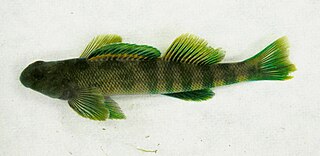
Etheostomatinae is a species-rich subfamily of freshwater ray-finned fish, the members of which are commonly known as the darters. The subfamily is part of the family Percidae which also includes the perches, ruffes and pikeperches. The family is endemic to North America. It consists of three to five different genera and well over 200 species. A common name for these fish in southern Indiana is pollywog.
